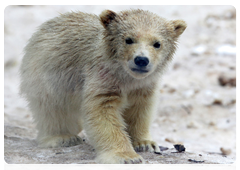MULTIMEDIA
 +
+
The polar bear, or the sea bear (Ursus maritimus) is a member of the bear family, Ursidae; the mammalian order Carnivora; the genus Ursus. The polar bear is the largest species of this genus
 +
+
The polar bear is the largest land carnivore and the only species of land mammals which has completely abandoned its habitat on land and moved to drifting ice floes in the Arctic Ocean
 +
+
The polar bear can weigh as much as 800 kilogrammes. The average male polar bear weighs 400 to 450 kilogrammes and the average female polar bear weighs 350 to 380 kilogrammes
 +
+
Polar bears are skilful hunters and are known for their good eyesight, sharp sense of smell and keen hearing. They mainly feed on two large species of Arctic seals: ringed seals and bearded seals (sea hares)
 +
+
Polar bears are typically solitary animals and do not form social groups, although hierarchy may be established when they are forced to congregate. They are generally peaceful when they are together
 +
+
Female polar bears tend to congregate in specific places, almost like maternity hospitals, where they dig out dens in the snow
 +
+
Polar bears are typically solitary animals and do not form social groups, although hierarchy may be established when they are forced to congregate
 +
+
The polar bear normally ranges over dense pack ice, swims well and migrates seasonally. If there are favourable ice conditions, polar bears can reach the North Pole during such migrations
 +
+
Polar bear experts with the International Union for the Conservation of Nature (IUCN) estimate that about 20,000 to 25,000 animals live in the Arctic today, but the animals’ numbers continue to decline
 +
+
The ongoing decrease in the ice cover in the Arctic means the loss of the most suitable habitat for polar bears







 ABOUT THE PROGRAMME
ABOUT THE PROGRAMME
 POLAR BEAR RESEARCH: A HISTORY
POLAR BEAR RESEARCH: A HISTORY
 POLAR BEAR: LIFE, BEHAVIOUR AND MORE
POLAR BEAR: LIFE, BEHAVIOUR AND MORE
 VLADIMIR PUTIN'S VISIT
VLADIMIR PUTIN'S VISIT
 NEWS
NEWS
 MULTIMEDIA
MULTIMEDIA